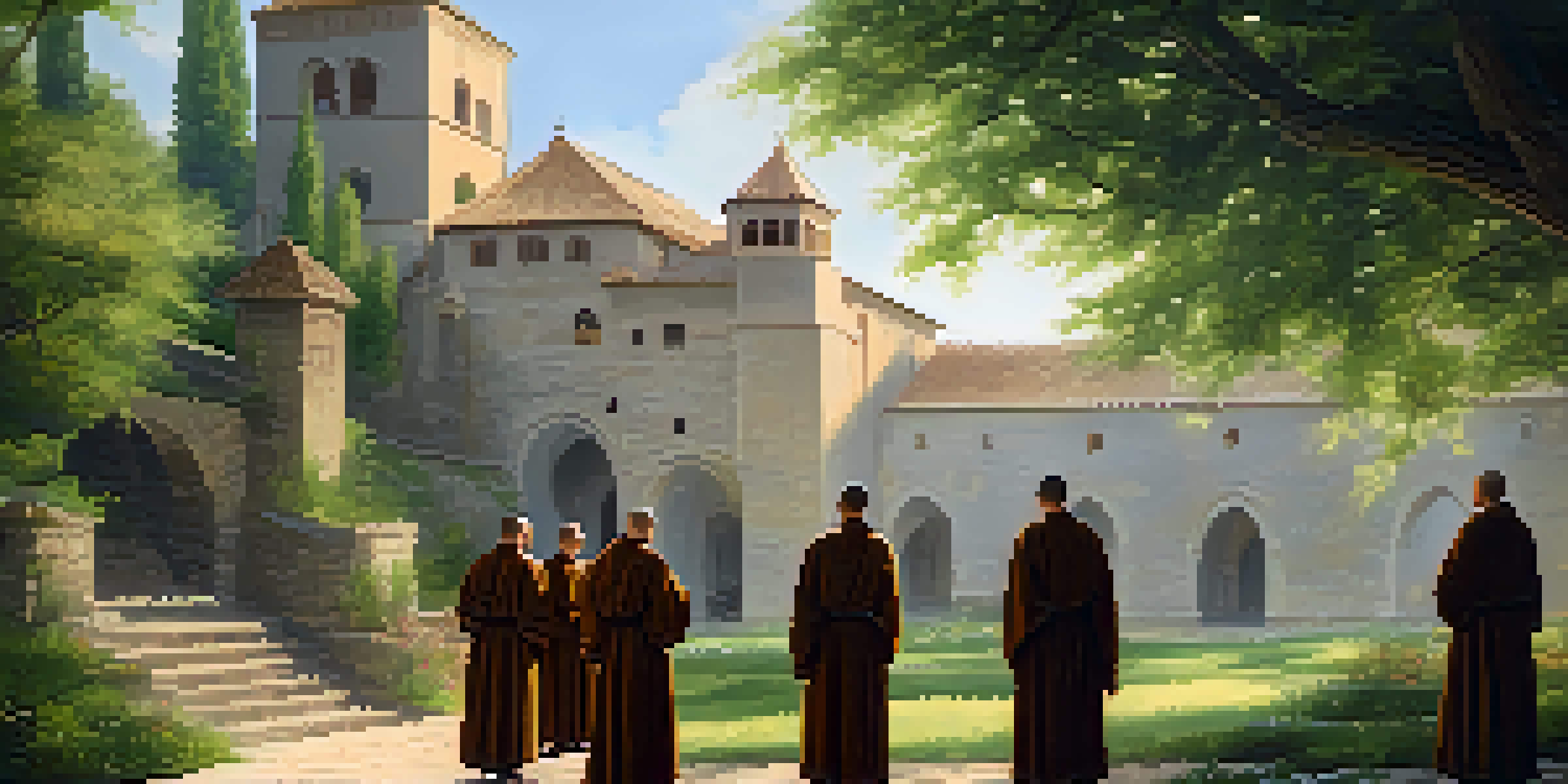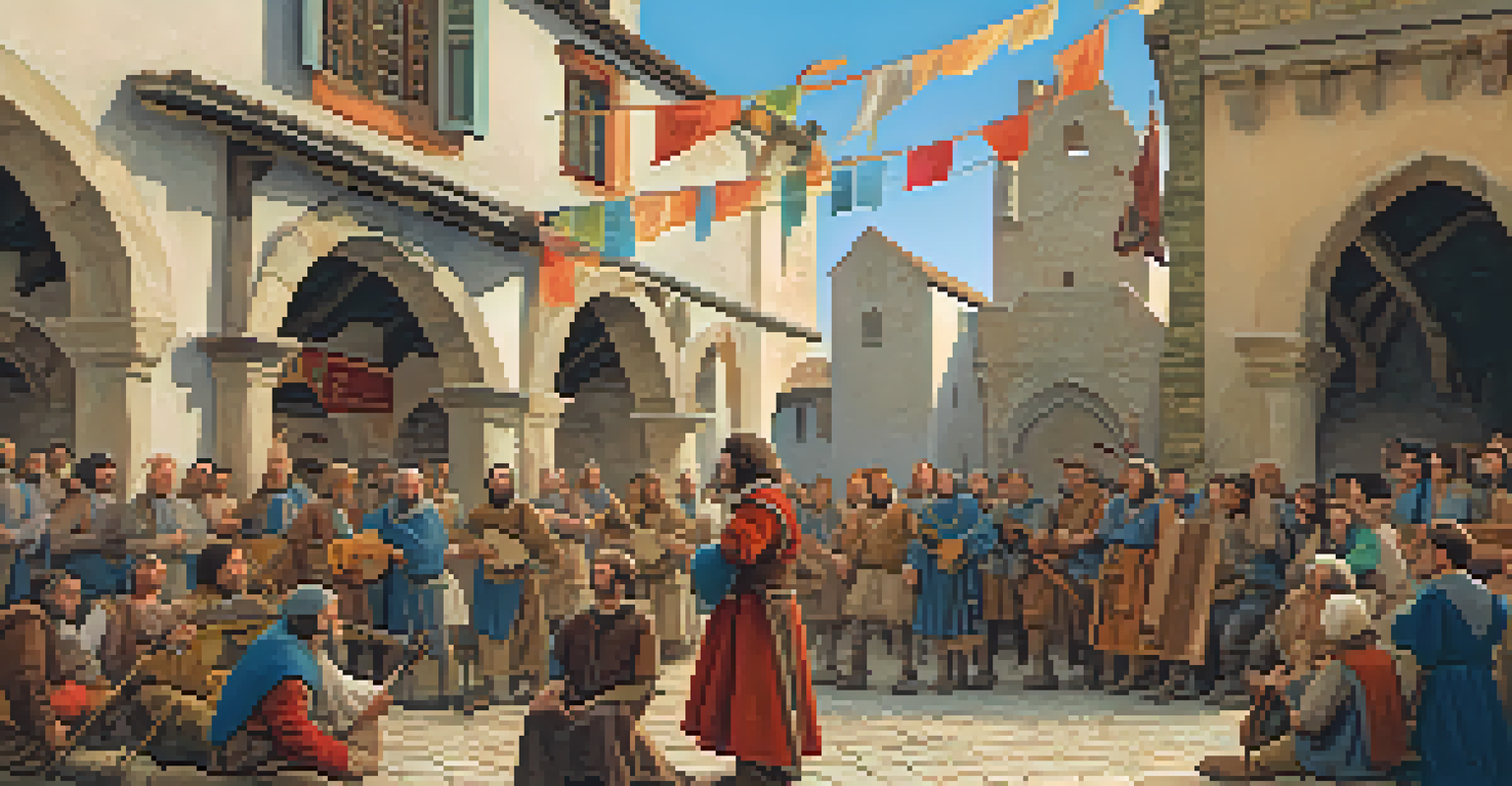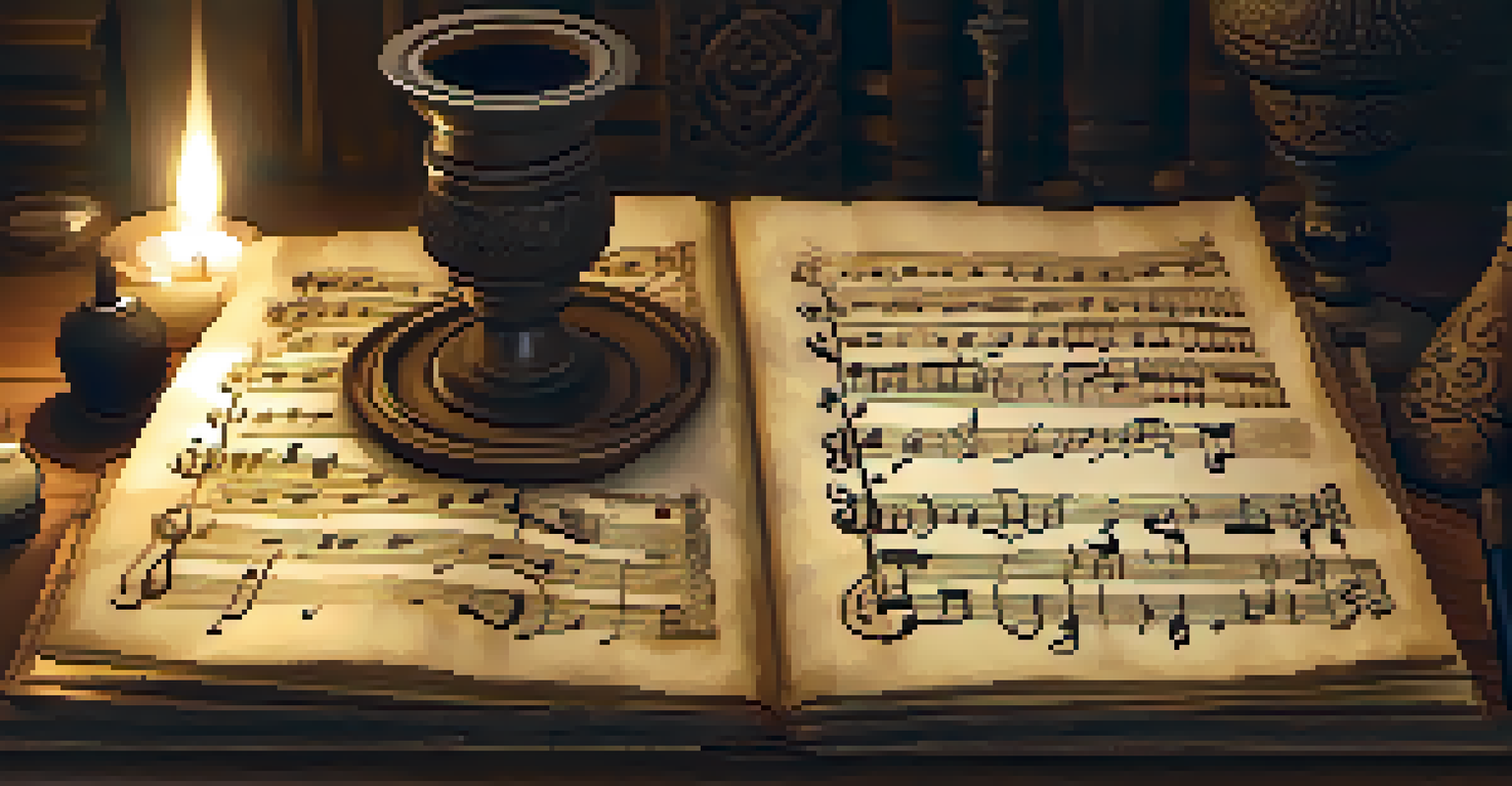Early Medieval Music: The Birth of Notation and Monody

Understanding the Early Medieval Era and Its Music
The Early Medieval period, spanning roughly from the 5th to the 10th century, was a time of significant transformation in Europe. Music played a vital role in both religious and secular life, reflecting the changing cultural landscape. This era laid the foundation for many musical traditions that would flourish in later centuries, making it a fascinating subject for exploration.
Music is the shorthand of emotion.
During this time, music was primarily an oral tradition, passed down through generations without formal records. Musicians relied on memory, improvisation, and local styles, making each performance unique. However, as the need for consistency grew, especially in liturgical settings, the birth of musical notation became essential.
The transition from oral traditions to written notation marked a pivotal moment in music history. It allowed for the preservation and dissemination of musical ideas across regions, leading to a more unified approach to musical practice. This shift enabled composers to explore more complex structures, paving the way for the development of monody and other musical forms.
The Role of the Church in Shaping Early Music
The Church was a dominant force in shaping music during the Early Medieval period. Its influence extended not only to the spiritual life of communities but also to the arts, including music. Gregorian chant, a form of plainchant, became the standard repertoire for worship, emphasizing the sacred nature of music.

Monophonic in texture, Gregorian chant featured a single melodic line that was often sung in Latin. This simplicity allowed the text's spiritual message to shine through, making it accessible to worshippers. The Church's sponsorship of music led to the establishment of schools where monks and clerics learned to chant and compose, further solidifying its importance.
Music's Evolution in the Medieval Era
The Early Medieval period marked a significant transformation in music, transitioning from oral traditions to the development of musical notation.
As a result, the Church's musical practices set the stage for future innovations. The need to standardize these chants across different regions prompted the development of early notation systems. This not only preserved the sacred music but also laid the groundwork for more complex musical forms that would emerge later.
Early Notation Systems: A Game Changer for Music
The development of musical notation in the Early Medieval period was revolutionary. Before this, music existed solely in the minds of performers, making it difficult to replicate compositions accurately. The introduction of notation allowed musicians to communicate their ideas more effectively, ensuring that music could be shared and preserved across generations.
Without music, life would be a mistake.
One of the earliest systems was neumatic notation, which used symbols called neumes to indicate pitch and rhythm. While this system was rudimentary, it represented a significant advancement in musical communication. It provided a framework for musicians to interpret compositions more consistently, leading to a richer musical experience.
As notation evolved, it became more refined, eventually leading to the development of staff notation. This innovation allowed for greater precision in conveying musical ideas, enabling composers to explore more intricate melodies and harmonies. The birth of notation not only transformed how music was created but also how it was understood and appreciated.
Monody: The Emergence of Solo Vocal Music
As notation systems improved, a new musical form began to emerge: monody. Characterized by a single melodic line accompanied by simple harmonies, monody allowed singers to express individual emotions and narratives. This shift marked a departure from the choral traditions of the past, emphasizing personal expression in music.
Monody often featured a clear, lyrical melody, making it accessible to audiences. This style became particularly popular in secular music, where themes of love, nature, and human experience were explored. The ability to convey emotion through a single voice opened up new avenues for composers and performers alike.
The Church's Influence on Music
The Church played a crucial role in shaping early music, standardizing practices through Gregorian chant and establishing educational institutions for musicians.
The rise of monody also paved the way for later developments in Western music, such as the emergence of opera and song. By focusing on individual expression, monody laid the groundwork for the rich tapestry of vocal music that would flourish in the Renaissance and beyond. Its influence can still be felt in contemporary music, highlighting its lasting legacy.
The Influence of Secular Music in the Early Medieval Period
While sacred music dominated the Early Medieval landscape, secular music also played a vital role in society. Troubadours and minstrels traveled from town to town, sharing stories and songs that reflected the everyday lives of people. This music often featured lively rhythms and relatable themes, making it a vital part of cultural expression.
Secular music provided a counterpoint to the solemnity of church music, allowing for a broader exploration of human experience. It encompassed a variety of forms, including ballads, dance tunes, and lyrical poetry. These songs often addressed love, valor, and the joys and sorrows of life, resonating with audiences on a personal level.
The interplay between sacred and secular music enriched the musical landscape of the Early Medieval period. As musicians blended elements from both realms, they fostered innovation and creativity. This fusion ultimately contributed to the emergence of new genres and styles, influencing the future of music as we know it.
Regional Variations in Early Medieval Music Practices
As music spread across Europe during the Early Medieval period, regional variations began to emerge. Different cultures and communities adapted musical practices to reflect their unique identities and traditions. This diversity enriched the musical tapestry of the time, leading to a wide range of styles and forms.
For instance, in the British Isles, local folk traditions coexisted with church music, resulting in a distinctive sound. Meanwhile, in the Mediterranean regions, the influence of Arabic music began to weave into the fabric of local practices, creating a rich blend of musical ideas. These regional variations contributed to the evolution of music, ensuring that it remained dynamic and relevant.
Secular Music's Cultural Impact
Despite the dominance of sacred music, secular music thrived, reflecting everyday life and fostering innovation through the interplay of various musical styles.
The sharing of musical ideas through trade and cultural exchange further facilitated these regional distinctions. As musicians traveled and collaborated, they brought elements from their own traditions into new contexts. This cross-pollination of ideas laid the groundwork for the diverse musical landscape that would flourish in the Middle Ages and beyond.
Conclusion: The Legacy of Early Medieval Music
The Early Medieval period was a time of profound change in the world of music, marked by the birth of notation and the rise of monody. These developments not only transformed how music was created and performed but also shaped the cultural identity of communities across Europe. The innovations of this era laid the groundwork for future musical advancements, influencing generations of musicians.
As we reflect on the impact of early medieval music, it's essential to recognize its enduring legacy. The foundations laid during this time continue to resonate in today's musical landscape, from the use of notation to the exploration of individual expression in song. Understanding this rich history allows us to appreciate the complexities and beauty of music as it has evolved.

In essence, the journey of early medieval music is a testament to human creativity and expression. As we unravel the threads of notation and monody, we uncover a story of innovation, cultural exchange, and the power of music to connect us all. This legacy inspires contemporary musicians and enriches our collective appreciation of the art form.